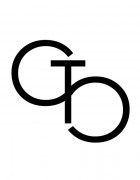A trip to W1 for a solo exhibition of new work by Korean-American artist Michael Joo called Radiohalo (Blain/Southern, London, 2016) is in order for Wednesday 17 February. Attending with my two-year-old daughter, the large space is a welcome contrast to central London’s busy corridors.
A radiohalo is, if you trust Wikipedia, a geological phenomenon of ‘microscopic, spherical shells of discolouration within minerals that occur in igneous rocks’ (Wikipedia, 2016). Like the rings of a tree that indicate its age, the radiohalos found in Joo’s work are a visual record of the processes that went towards the making of the work. Like an impractical CSI laboratory technique, they are historical and conceptual documents that relate to individual actions or personal spaces such as the artist’s studio.
The gallery describes the ‘calorific’ (to do with calorie consumption and expenditure) tray paintings of silver nitrate and epoxy ink on canvas, as representative of an individuals energy transfer over a period of one second of activity such as standing or lying down. Which individual is being referred to here? We have to take it on trust that the artist ‘meticulously calculated the number of calories individuals would expend performing various actions’ because it is not stated how this was worked out. If the artist is using his own body as a way to work out an average for all people, making the paintings ‘a unique self-portrait for each spectator’ then it seems strange that this information is being held back. It is as if the artist is reluctant to put himself in the picture, which is a typically Korean trait in a culture that promotes conformity. Nevertheless, I think the burden of proof definitely lies with Blain/Southern when they claim that, ‘Joo gauged the number of calories used per millisecond as a person transforms from human to God’.
Thematically coherent but lacking any real sense of playfulness, Joo hides behind the techniques of his craft. He merely iterates on his concepts (albeit successfully) without really challenging them. By collecting used commercial baking trays for his tray paintings, Joo is using an everyday item that ‘comes with the assumption that the everyday is both authentic and democratic’ (Johnstone, 2008: 12-13). This exhibition is really about authenticity and trust. Do we believe Joo’s assertion that each painting ‘depicts an individual quantifiable second of energy’? There are too many liberties on display here and, like many exhibitions of this nature, the contextual information is essential in making sense of the work.
As a final note, regarding the printed handout it is claimed that the 6th Gwangju Biennale (for which Joo won the grand prize) took place in Seoul. The Gwangju Biennale takes place in Gwangju, a city several hundred miles south of Seoul and not to be confused with the Gwangju sub-region of Seoul’s outer suburbs, which would take the questions of subjectivity proposed by this exhibition just a little too far.
Joe Stevens
Rating: G[i]
Joe Stevens graduated with an MA in Interactive Media from Goldsmiths in 2007. As a self-professed artist, athlete and academic, Stevens’ work has been included in exhibitions at The National Art Studio (Seoul, 2008), Tenderpixel (London, 2010) and HOUSE Gallery (London, 2014), opening events at APT and Goldsmiths (London, 2007), residences at IASK (South Korea, 2008) and Loopart13 (London, 2013) and publications in Rubric Journal (2009) and Mind Body Spirit (2012, 2013).
Notes
[i] The Wine Games five point scale (from worst to best) is a system for assessing cultural output and consists of the following ratings: Yellow (Y); Red (R); Green (G); Orange (O) and Black (B).
Bibliography
Johnstone, Stephen, (2008) ‘Recent Art and the Everyday’ in Johnstone, Stephen, (2008), Documents of Contemporary Art: The Everyday. Whitechapel Gallery and the MIT Press.
Wikipedia, (2016), Radiohalo. https://en.wikipedia.org/wiki/Radiohalo (accessed 2 March 2016).
Featured Image:
Peter Mallet, (2016), Installation shot. Courtesy of Blain/Southern.


Reblogged this on HOME.
Pingback: Performing the Wine Dice: Michael Joo’s Radiohalo | JOE STEVENS